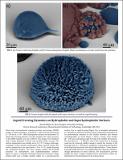Liquid Freezing Dynamics on Hydrophobic and Superhydrophobic Surfaces
Author(s)
Miljkovic, Nenad; Enright, Ryan; Wang, Evelyn N.
DownloadMain article, figures, and supplementary information (471.3Kb)
OPEN_ACCESS_POLICY
Open Access Policy
Creative Commons Attribution-Noncommercial-Share Alike
Terms of use
Metadata
Show full item recordAbstract
False color environmental scanning electron microscope (ESEM) images of water freezing on smooth (θe ≈ 120°) and nanostructured (l ~ 50 nm, θe ≈ 170 - 180°) hydrophobic surfaces are presented. To obtain the freezing dynamics of water droplets, the vapor pressure in the ESEM chamber was set to 800 Pa. The images were obtained with a beam potential of 20 kV and variable probe current. The surface temperature was initially set to 5 ± 1.5 °C using a cold stage, resulting in water droplet condensation. After a period of time, the surface temperature was decreased to -20 ± 1.5 °C, rapidly freezing the condensed droplets. The three images capture the freezing dynamics on hydrophobic and superhydrophobic surfaces. Figure 1a shows a snapshot of droplet coalescence between a large droplet (left) and a smaller droplet (right) on a nanostructured surface. Due to rapid freezing (Figure 1b), ice droplets maintained an ‘amorphous’ spherical structure (blue). Subsequent deposition of ice preferentially initiated on the droplet interface and formed crystallographic ice (red). Figure 2 shows a larger scale droplet (R ~ 100 μm) undergoing rapid freezing with notable protrusions. The heat flux (q” ~ 1 GW/m2) due to the latent heat of freezing could not be removed rapidly enough to match the velocity of the freezing front (vf ≈ 1500 m/s), resulting in evaporation and ejection of the liquid (protrusions) from the droplet interface. These distinct freezing droplet behaviors can significantly alter dynamics of phasechange phenomena on these surfaces. The visualizations provide insight into these complex droplet-surface interactions, which are important for the development of de-icing surfaces.
Date issued
2012-06Department
Massachusetts Institute of Technology. Department of Mechanical EngineeringJournal
Journal of Heat Transfer
Publisher
ASME International
Citation
Miljkovic, Nenad, Ryan Enright, and Evelyn N Wang. “Liquid Freezing Dynamics on Hydrophobic and Superhydrophobic Surfaces.” Journal of Heat Transfer 134, no. 8 (2012): 080902.
Version: Author's final manuscript
ISSN
00221481